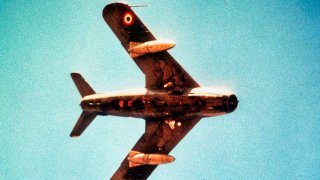Russia's MiG-17 Was the One Fighter the U.S. Air Force Hated
Over the years, the MiG-17 was licensed-built in China as the Shenyang J-15 and in Poland as the PZL-Mielec Lim-6. Today, the Fresco continues to be flown by the North Korean air force.
The Soviet-era MiG-17 fighter aircraft is perhaps most recognized for its role in the Vietnam War.
During the early 1950’s, the high-subsonic airframe was first produced and would soon be operated by an array of air forces across the globe.
Initially designed to effectively shoot down American bombers with slower top speeds, the Soviet fighter proved to be a success during the Vietnam War when North Vietnamese pilots were able to combat U.S. fighters and airframes.
The origin story of the MiG-17
Designated by the North Atlantic Treaty Organization (NATO) as Fresco, the MiG-17 once represented a major threat to American aerial tactics. Back in the late 1940’s, Soviet engineers first conceptualized a replacement platform for the existing MiG-15.
Engineers were tasked with designing an airframe that could safely exceed Mach-.92 in speed, which is the maximum speed that the MiG-15 could fly before losing control. Although similar in appearance to its predecessor, the Fresco featured a longer fuselage, enhanced space and sharply swept wings.
When the platform first made its debut, Western intelligence officers believed the Soviet platform was simply an upgraded variant of the MiG-15. However, upon closer inspection, it became clear that the Fresco was quite different.
In terms of firepower, the Fresco was armed to the teeth. One 37mm autocannon and two 23mm autocannons were incorporated into the airframe. Additionally, the Soviet fighter could lug up to 1,000 pounds of external pylons, although these pylons were primarily used as extra fuel storage.
Each MiG-17 Fresco airframe possessed a range of roughly 500 miles, which nearly doubled with the addition of full external fuel tanks. Later Fresco variants that entered service with the USSR would also be equipped with an advanced Izumrud RP-2 radar.
The MiG-17 Fresco in Vietnam
By the 1960’s, the Soviets were developing newer and more capable airframes. While the USSR considered the MiG-17 to be old news during this decade, the North Vietnamese proved that these aging fighters could be made useful in combat.

In a report on Soviet aviation penned for the Smithsonian, expert Ilya Grinberg described the Fresco’s formidable role in the war: “The strength of the MiG-17F was its small size, which made it difficult to visually locate, as well as its ability to launch from primitive airstrips,” said Grinberg, adding that the North Vietnamese pilots spoke highly of the MiG‑17’s maneuverability, simplicity of construction, and effectiveness of armament.” Another Soviet aviation historian also outlined that the Fresco’s “[afterburner-sustained turns in a close-in ‘fur-ball’ could be lethal. ‘That little airplane can give you a tussle the likes of which you’ve never had before in your life,’ Colonel Robin Olds, Rolling Thunder’s most successful fighter pilot, told a study team in 1967, adding ‘Their turn radius has to be seen to be believed. It’s incredible.’”

Over the years, the MiG-17 was licensed-built in China as the Shenyang J-15 and in Poland as the PZL-Mielec Lim-6. Today, the Fresco continues to be flown by the North Korean air force.
Maya Carlin, National Security Writer with The National Interest, is an analyst with the Center for Security Policy and a former Anna Sobol Levy Fellow at IDC Herzliya in Israel. She has by-lines in many publications, including The National Interest, Jerusalem Post, and Times of Israel. You can follow her on Twitter: @MayaCarlin.
All images are Creative Commons.


